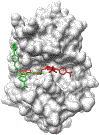Predicting protein-ligand binding modes for CELPP and GC3: workflows and insight
- PMID: 30689079
- PMCID: PMC6494980
- DOI: 10.1007/s10822-019-00185-0
Predicting protein-ligand binding modes for CELPP and GC3: workflows and insight
Abstract
Drug Design Data Resource (D3R) continues to release valuable benchmarking datasets to promote improvement and development of computational methods for new drug discovery. We have developed several methods for protein-ligand binding mode prediction during the participation in the D3R challenges. In the present study, these methods were integrated, automated, and systematically tested using the large-scale data from Continuous Evaluation of Ligand Pose Prediction (CELPP) and a subset of Grand challenge 3 (GC3). The results show that current molecular docking methods benefit from the increasing number of protein-ligand complex structures deposited in Protein Data Bank. Using an appropriate protein structure for docking significantly improves the success rate of the binding mode prediction. The results of our template-based method and docking method are compared and discussed. Our future direction include the combination of these two methods for binding mode prediction.
Keywords: Drug discovery; Molecular docking; Molecular similarity; Protein–ligand interaction; Template-based.
Figures



Similar articles
-
Dissimilar Ligands Bind in a Similar Fashion: A Guide to Ligand Binding-Mode Prediction with Application to CELPP Studies.Int J Mol Sci. 2021 Nov 15;22(22):12320. doi: 10.3390/ijms222212320. Int J Mol Sci. 2021. PMID: 34830201 Free PMC article.
-
Shape similarity guided pose prediction: lessons from D3R Grand Challenge 3.J Comput Aided Mol Des. 2019 Jan;33(1):47-59. doi: 10.1007/s10822-018-0142-x. Epub 2018 Aug 6. J Comput Aided Mol Des. 2019. PMID: 30084081
-
Improving ligand 3D shape similarity-based pose prediction with a continuum solvent model.J Comput Aided Mol Des. 2019 Dec;33(12):1045-1055. doi: 10.1007/s10822-019-00220-0. Epub 2019 Aug 28. J Comput Aided Mol Des. 2019. PMID: 31463704
-
Advances and challenges in protein-ligand docking.Int J Mol Sci. 2010 Aug 18;11(8):3016-34. doi: 10.3390/ijms11083016. Int J Mol Sci. 2010. PMID: 21152288 Free PMC article. Review.
-
Advances in Docking.Curr Med Chem. 2019;26(42):7555-7580. doi: 10.2174/0929867325666180904115000. Curr Med Chem. 2019. PMID: 30182836 Review.
Cited by
-
Modulating the voltage sensor of a cardiac potassium channel shows antiarrhythmic effects.Proc Natl Acad Sci U S A. 2021 May 18;118(20):e2024215118. doi: 10.1073/pnas.2024215118. Proc Natl Acad Sci U S A. 2021. PMID: 33990467 Free PMC article.
-
Macrocycle modeling in ICM: benchmarking and evaluation in D3R Grand Challenge 4.J Comput Aided Mol Des. 2019 Dec;33(12):1057-1069. doi: 10.1007/s10822-019-00225-9. Epub 2019 Oct 9. J Comput Aided Mol Des. 2019. PMID: 31598897
-
An allosteric modulator activates BK channels by perturbing coupling between Ca2+ binding and pore opening.Nat Commun. 2022 Nov 9;13(1):6784. doi: 10.1038/s41467-022-34359-6. Nat Commun. 2022. PMID: 36351900 Free PMC article.
-
Dissimilar Ligands Bind in a Similar Fashion: A Guide to Ligand Binding-Mode Prediction with Application to CELPP Studies.Int J Mol Sci. 2021 Nov 15;22(22):12320. doi: 10.3390/ijms222212320. Int J Mol Sci. 2021. PMID: 34830201 Free PMC article.
-
A PIP2 substitute mediates voltage sensor-pore coupling in KCNQ activation.Commun Biol. 2020 Jul 16;3(1):385. doi: 10.1038/s42003-020-1104-0. Commun Biol. 2020. PMID: 32678288 Free PMC article.
References
-
- Kitchen DB, Decornez H, Furr JR, Bajorath J (2004) Docking and scoring in virtual screening for drug discovery: methods and applications. Nat Rev Drug Discov 3:935–947. - PubMed
-
- Brooijmans N, Kuntz ID. (2003) Molecular recognition and docking algorithms. Annual review of biophysics and biomolecular structure. 2003 June;32(1):335–373. - PubMed
Publication types
MeSH terms
Substances
Grants and funding
LinkOut - more resources
Full Text Sources

